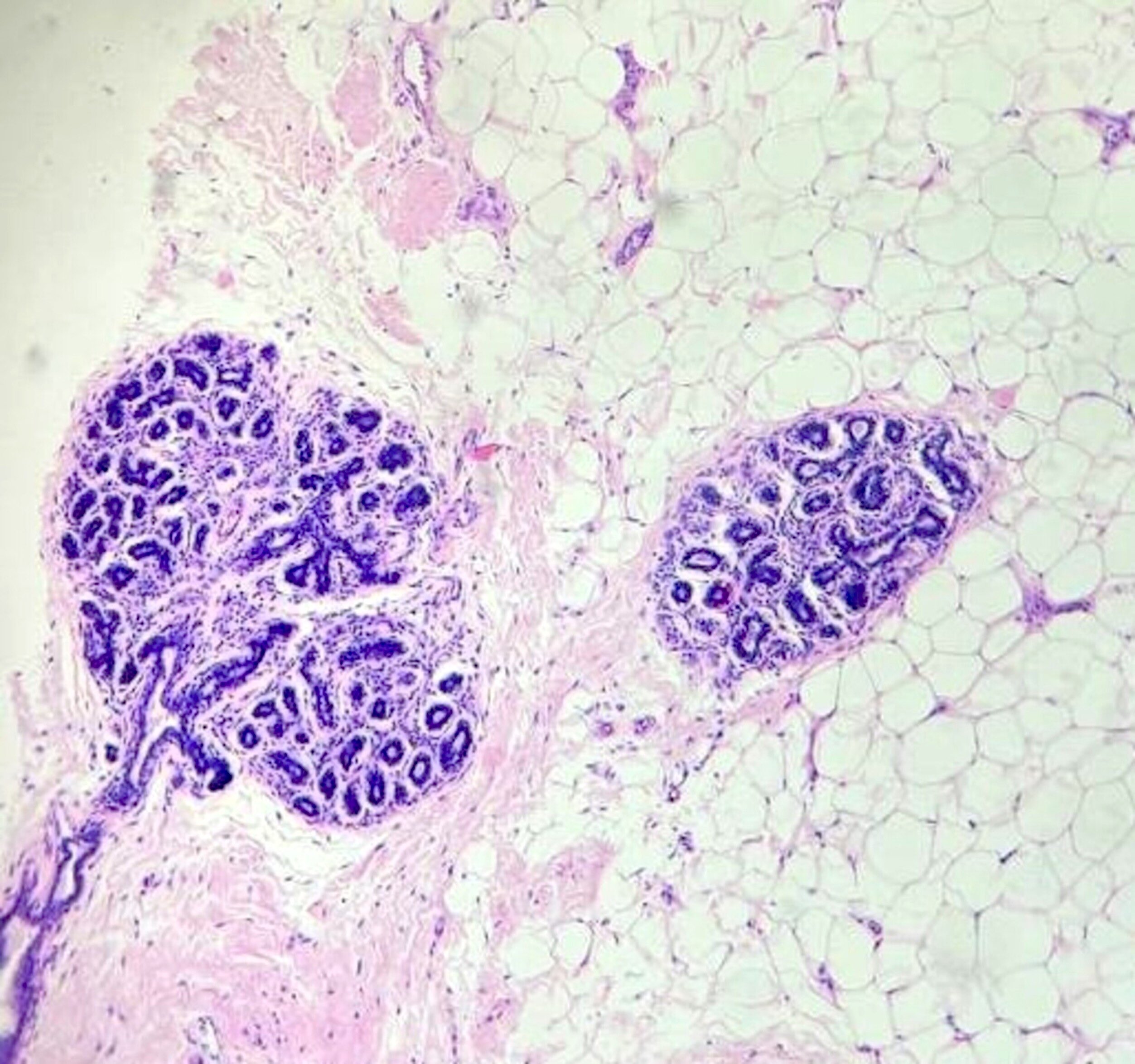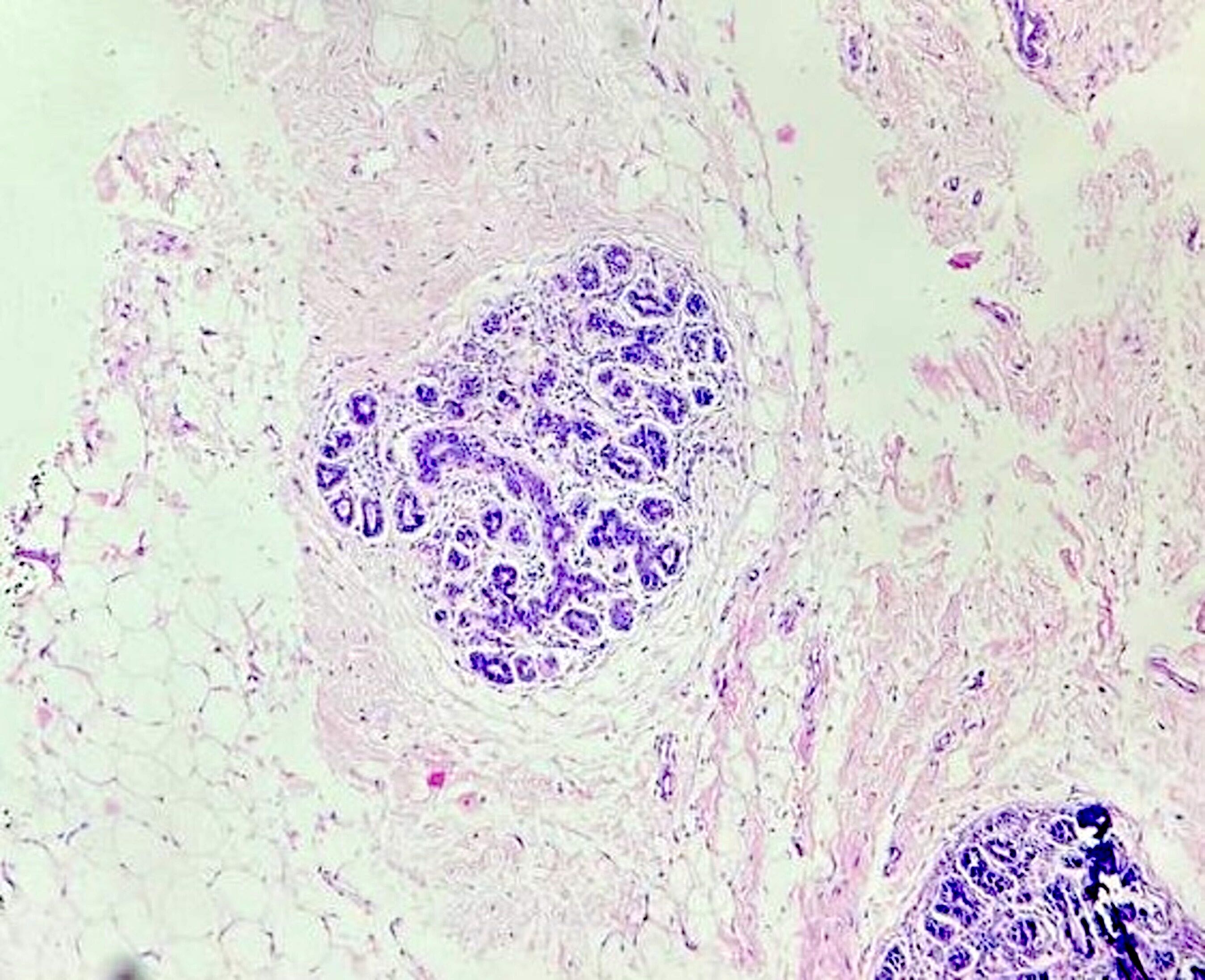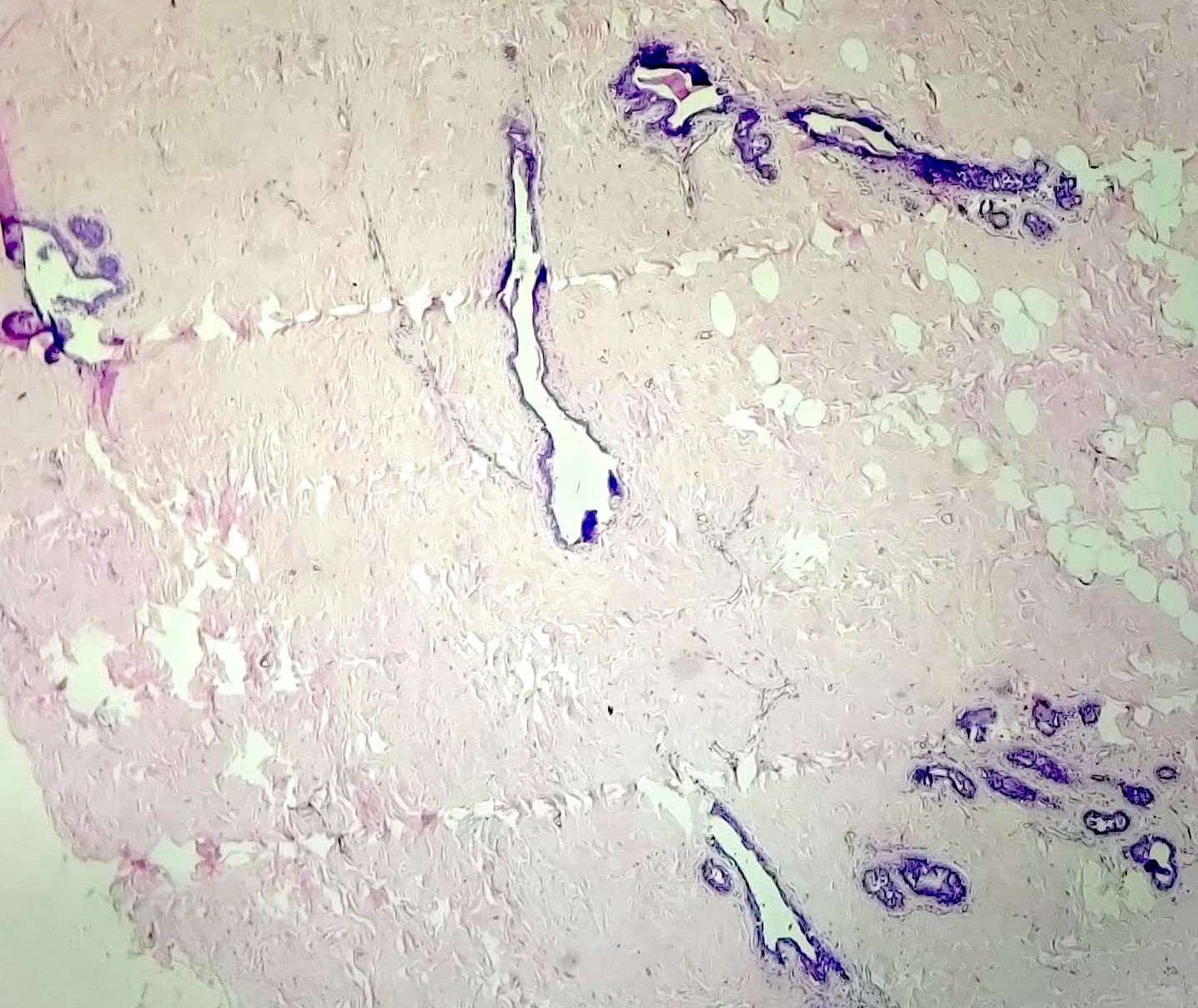Table of Contents
Definition / general | Essential features | Terminology | Epidemiology | Sites | Etiology | Clinical features | Diagnosis | Case reports | Treatment | Clinical images | Microscopic (histologic) description | Microscopic (histologic) images | Sample pathology report | Differential diagnosis | Board review style question #1 | Board review style answer #1Cite this page: Tomar R. Amastia / aplasia / hypoplasia / athelia. PathologyOutlines.com website. https://www.pathologyoutlines.com/topic/breastamastia.html. Accessed May 12th, 2024.
Definition / general
- Amastia: complete absence of breast and nipple - areola complex (NAC) (J Pediatr Endocrinol Metab 2003;16:471)
- Aplasia / hypoplasia: failure of breast growth despite presence of mammary gland (J Pediatr Endocrinol Metab 2003;16:471)
- Athelia: congenital absence of nipple - areola complex (J Pediatr Endocrinol Metab 2003;16:471)
Essential features
- Congenital breast anomalies are rare; unilateral or bilateral
- Athelia and amastia are associated with Poland syndrome
- Amastia can be part of other syndromes, such as acral renal ectodermal dysplasia lipoatrophic diabetes (AREDYLD) syndrome
- Athelia can be congenital or acquired
- Breast reconstruction using transverse rectus abdominis muscle (TRAM) flap and nipple - areola reconstruction is the treatment of choice
Terminology
- Polymastia: presence of > 2 breasts (J Pediatr Endocrinol Metab 2003;16:471)
- Polythelia: many nipples (J Pediatr Endocrinol Metab 2003;16:471)
Epidemiology
- All congenital breast anomalies are rare, athelia being the rarest (J Pediatr Endocrinol Metab 2003;16:471)
- Amastia: F > M (F:M = 5:1) (J Pediatr Endocrinol Metab 2003;16:471)
- Amastia can occur in young males (Neurol India 2019;67:1167)
- Polythelia: M:F = 1.7:1 (J Pediatr Endocrinol Metab 2003;16:471)
Sites
- Congenital anomalies can be unilateral or bilateral (unilateral amastia is associated with Poland syndrome) (J Pediatr Endocrinol Metab 2003;16:471)
Etiology
- Amastia occurs due to complete failure of mammary line development at 6 weeks in utero (J Pediatr Endocrinol Metab 2003;16:471)
- Unilateral amastia is frequently associated with the absence of the pectoralis major muscle (Poland sequence) (J Pediatr Endocrinol Metab 2003;16:471)
- Amastia can be part of other syndromes, such as AREDYLD syndrome (Indian J Pediatr 2013;80:870)
- Polymastia presents with 2 general patterns: supernumerary breast (SNB) and aberrant (accessory) mammary tissue (AMT) (J Pediatr Endocrinol Metab 2003;16:471)
- Unilateral mammary hypoplasia / aplasia has been reported in conjunction with Becker nevus and Poland sequence (J Pediatr Endocrinol Metab 2003;16:471)
- Unilateral hypoplasia can be associated with nevus depigmentosus (Dermatol Online J 2004;10:12)
- Breast hypoplasia is one of the reasons for insufficient milk supply (J Hum Lact 2021;37:242)
- Breast hypoplasia can occur after infantile hemangioma (J Eur Acad Dermatol Venereol 2017;31:e355)
- Athelia can be congenital or acquired; acquired due to trauma or ablation (Br J Plast Surg 2005;58:833)
- Athelia can occur due to failure in parathyroid hormone related protein production (Br J Plast Surg 2005;58:833)
- Athelia may be isolated or associated with other anomalies, such as dermoid cysts, pectus excavatum, choanal atresia posterior or renal tubular dysgenesis (J Pediatr Endocrinol Metab 2003;16:471)
- Unilateral athelia has been described in Poland sequence and bilateral athelia in ectodermal dysplasia (tricho-odonto-onychial type) and scalp ear nipple syndrome (J Pediatr Endocrinol Metab 2003;16:471)
Clinical features
- Patients usually present with no breast development with or without nipple - areola complex in pediatric or surgery outpatient department (OPD)
Diagnosis
- Ultrasound is the preferred method for diagnosis as compared to mammography (Korean J Radiol 2018;19:978)
Case reports
- 3 year old girl with a case of congenital jejunal atresia associated with bilateral athelia and choanal atresia (Clin Dysmorphol 2006;15:37)
- 3 year old girl presented with bilateral congenital amastia (Indian J Pediatr 2013;80:870)
- 14 year old boy with Poland syndrome with amastia and athelia (Neurol India 2019;67:1167)
- 17 year old girl with bilateral athelia (Br J Plast Surg 2005;58:833)
- 17 year old girl with congenital unilateral amastia underwent a 3 step reconstruction of breast (Cureus 2021;13:e18540)
- 19 year old woman presented with breast hypoplasia after infantile hemangioma (J Eur Acad Dermatol Venereol 2017;31:e355)
Treatment
- 3 step breast reconstruction surgery in amastia (Cureus 2021;13:e18540)
- Nipple - areola reconstruction in bilateral athelia (Br J Plast Surg 2005;58:833)
- Breast reconstruction for aplasia using free TRAM flap (Acta Chir Plast 2001;43:39)
Clinical images
Microscopic (histologic) description
- Histopathology of hypoplasia is mostly normal; sometimes shows decreased gland to stroma ratio with predominance of fibrocollagenous stroma and mature adipose tissue
- Histologically, both unilateral and bilateral hypoplastic breast tissue consists of fibrous stroma and ductal structures without acinar differentiation
- Ducts typically resemble those in the prepubertal breast and lack lobular development (Semin Plast Surg 2013;27:42)
Microscopic (histologic) images
Sample pathology report
- Left breast, trucut biopsy:
- Rare benign breast ductules with fibrocollagenous stroma (clinically breast hypoplasia) (see comment)
- Comment: A 16 year old girl presented with left side hypoplasia in surgery OPD. Trucut biopsy was done from left breast.
- Gross: 4 trucut cores of breast swelling measuring 1 x 0.2 cm, 0.8 x 0.2 cm, 0.7 x 0.1 cm and 1.1 x 0.2 cm
- Microscopy: Section shows few benign breast ductules with fibrocollagenous stroma. Predominance of mature adipose tissue seen. No features of atypia are seen.
Differential diagnosis
- Turner syndrome:
- Can present with hypoplasia
- Presents as amenorrhea, short stature and webbed neck, which is not present in breast congenital anomalies
- Karyotyping is 45X, whereas breast congenital anomalies karyotyping is normal 46XX
Board review style question #1
A 16 year old, normal statured girl presents to the general surgery outpatient department with no development of breast on both sides. On ultrasonography (USG) of the abdomen, uterus and bilateral ovaries are normal. Menstrual cycles are regular. Karyotyping shows 46XX. Which of the following syndromes can be associated with this condition?
- Androgen insensitivity syndrome
- Klinefelter syndrome
- Poland syndrome
- Turner syndrome
Board review style answer #1
C. Poland syndrome. Bilateral amastia is very commonly associated with Poland syndrome.
Answer D is incorrect because Turner syndrome presents as short stature and amenorrhea.
Answer B is incorrect because Klinefelter syndrome is 46XXY on karyotyping.
Answer A is incorrect because androgen insensitivity syndrome patients have no uterus or ovaries but can have normal breast development.
Comment Here
Reference: Amastia / aplasia / hypoplasia / athelia
Comment Here
Reference: Amastia / aplasia / hypoplasia / athelia












